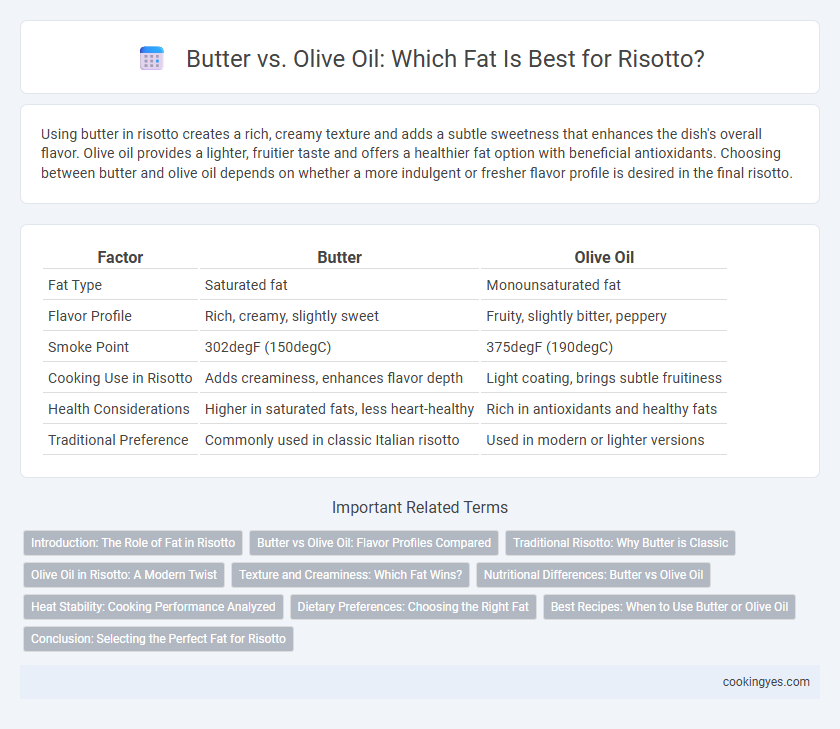Using butter in risotto creates a rich, creamy texture and adds a subtle sweetness that enhances the dish's overall flavor. Olive oil provides a lighter, fruitier taste and offers a healthier fat option with beneficial antioxidants. Choosing between butter and olive oil depends on whether a more indulgent or fresher flavor profile is desired in the final risotto.
Table of Comparison
| Factor | Butter | Olive Oil |
|---|---|---|
| Fat Type | Saturated fat | Monounsaturated fat |
| Flavor Profile | Rich, creamy, slightly sweet | Fruity, slightly bitter, peppery |
| Smoke Point | 302degF (150degC) | 375degF (190degC) |
| Cooking Use in Risotto | Adds creaminess, enhances flavor depth | Light coating, brings subtle fruitiness |
| Health Considerations | Higher in saturated fats, less heart-healthy | Rich in antioxidants and healthy fats |
| Traditional Preference | Commonly used in classic Italian risotto | Used in modern or lighter versions |
Introduction: The Role of Fat in Risotto
Butter and olive oil both play crucial roles in risotto by providing the essential fat that influences texture and flavor development. Butter contributes a rich, creamy mouthfeel and enhances the dish's overall smoothness, while olive oil offers a lighter, fruitier taste and helps to toast the rice evenly without overpowering other ingredients. The choice between butter and olive oil affects the risotto's final profile, balancing richness and subtlety throughout the cooking process.
Butter vs Olive Oil: Flavor Profiles Compared
Butter imparts a rich, creamy flavor to risotto, enhancing its natural sweetness and providing a velvety texture. Olive oil introduces a fruity, slightly peppery taste that complements the starchiness of the rice without overpowering other ingredients. Choosing between butter and olive oil depends on desired flavor intensity and the specific style of risotto being prepared.
Traditional Risotto: Why Butter is Classic
Butter remains the classic fat choice in traditional risotto, offering a creamy texture and rich flavor that olive oil cannot precisely replicate. The milk solids in butter help create the characteristic silkiness and depth of taste essential to authentic risotto dishes. This preparation technique, rooted in Italian culinary heritage, balances the starch released from Arborio or Carnaroli rice for the perfect, luscious consistency.
Olive Oil in Risotto: A Modern Twist
Olive oil adds a contemporary twist to risotto by infusing it with a fruity, slightly peppery flavor that enhances the dish's overall complexity. Its lower saturated fat content and high antioxidants make it a heart-healthy alternative to butter while still providing a smooth, creamy texture when properly emulsified with the starch from Arborio rice. Using extra virgin olive oil in risotto not only elevates its nutritional profile but also complements Mediterranean-inspired ingredients like tomatoes, basil, and seafood.
Texture and Creaminess: Which Fat Wins?
Butter enhances risotto with a rich, velvety texture and superior creaminess due to its milk fat content, which emulsifies beautifully during cooking. Olive oil offers a lighter, silkier mouthfeel but lacks the full-bodied creaminess that butter imparts to the dish. For a traditional, indulgent risotto texture, butter remains the preferred fat for achieving optimal creaminess.
Nutritional Differences: Butter vs Olive Oil
Butter contains saturated fats and cholesterol, contributing to higher calorie content and potential heart health concerns, whereas olive oil is rich in monounsaturated fats and antioxidants that support cardiovascular health. Olive oil offers beneficial compounds like vitamin E and polyphenols, which have anti-inflammatory properties, making it a healthier option for risotto preparations. Nutritionally, choosing olive oil over butter can reduce saturated fat intake while providing essential fatty acids that promote overall well-being.
Heat Stability: Cooking Performance Analyzed
Butter and olive oil differ significantly in heat stability, influencing risotto's cooking process. Olive oil has a higher smoke point (about 375degF to 420degF), allowing it to withstand the initial toasting of rice grains without burning, whereas butter's lower smoke point (around 300degF to 350degF) can lead to browning or burning if overheated. For optimal cooking performance, blending butter with olive oil balances flavor richness and heat tolerance, ensuring the rice cooks evenly without scorching.
Dietary Preferences: Choosing the Right Fat
Butter offers a rich, creamy flavor and is a traditional choice for risotto, providing saturated fats that enhance texture and taste. Olive oil, rich in monounsaturated fats and antioxidants, caters to Mediterranean diets and is preferred for its health benefits and lighter mouthfeel. Selecting between butter and olive oil depends on dietary preferences, such as avoiding dairy or prioritizing heart-healthy fats.
Best Recipes: When to Use Butter or Olive Oil
Butter enhances risotto with a rich, creamy texture and nutty flavor, making it ideal for classic recipes like mushroom or Parmesan risotto. Olive oil offers a lighter, fruitier taste and higher smoke point, perfect for vegetable or seafood risottos where a delicate flavor profile is desired. For optimal results, combine both fats by sauteing onions in olive oil and finishing with butter to balance richness and freshness.
Conclusion: Selecting the Perfect Fat for Risotto
Butter offers a creamy texture and rich flavor that enhances the traditional risotto experience, while olive oil provides a lighter, fruitier taste and better heat stability. Selecting the perfect fat depends on your desired flavor profile and dietary preferences, with butter favored for indulgence and olive oil preferred for a healthier alternative. Both fats contribute to the silkiness essential in risotto, ensuring a harmonious balance between taste and texture.
Butter vs olive oil for fat Infographic

 cookingyes.com
cookingyes.com